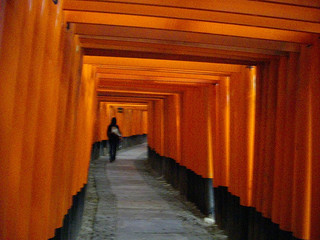



- Japanese: 鳥居 (torii)
Torii are the gates which mark the entrances to Shinto shrines. They bear a simple but distinctive form, widely recognized around the world and associated with Japan, if not specifically with Shinto: two pillars supporting two horizontal cross-beams, the upper of which is often curved upwards. Torii are traditionally made of wood, and are often painted vermillion, but also appear in other materials, including stone, and in some cases of those erected in the modern period, iron, bronze, and concrete.
Shrines typically possess not just one torii, but multiple gateways, arranged in a series, to mark the increasing sacredness of the space as one passes through one gateway after another, proceeding deeper into the shrine grounds. At some larger or more prominent shrines, torii can be found at a significant distance from the shrine grounds themselves, arranged at the entrance to, and at intervals along, an omotesandô, a street approaching the shrine. Inari shrines are distinctive for having hundreds or even thousands of torii lined up one after another, almost tunnel-like in aggregate; however, while this is a widely known and stereotypical image of "Japan," it is almost exclusively found only at Inari shrines. Smaller shrines sometimes use a ceremonial rope (shimenawa) festooned with folded paper (shide) instead of torii.
While torii have been erected at Shinto shrines since ancient times, it is important to recognize and remember that as with many other aspects of shrine architecture, and of Shinto more broadly, the nationalist & nationalizing efforts of the Meiji government in constructing State Shinto in the late 19th and early 20th centuries had a profoundly transformative effect upon the forms, meaning, and content of Shinto shrines - which shrines survive and which do not, which gods or spirits they are dedicated to, and so forth. While some shrines, such as Yasaka Shrine in Kyoto, boasted monumentally large torii in the Edo period or even earlier, many of the largest torii in the country are not so traditional, or deeply historical, but also date to Japan's Meiji period adoption of Western notions of the role of monumental architecture in proclaiming the national greatness and power. The first torii ever erected in bronze was one at Yasukuni Shrine; erected in 1887, it was also at that time the largest torii in the country. A great many shrines were destroyed in Allied bombing of Japan's cities in World War II, but of those which survived or were rebuilt, nine of the ten largest torii in the country as of 1974 had been built in 1875 or later. The only one of the ten from prior to the Meiji period is one which stands at Yasaka Shrine in Kyoto. The largest in the country at that time was another gate at Yasukuni, erected in that year. Some of the largest torii standing in Japan today thus include:
- Torii at Yasaka Shrine, Kyoto, pre-Meiji, ninth tallest as of 1974
- Torii at Meiji Shrine, Tokyo, 12 meters, 1920
- Bronze torii at Yasukuni Shrine, Tokyo, over 15 meters, 1887
- Torii at Izumo Shrine, Shimane prefecture, 22 meters, 1915
- Torii at Heian Shrine, Kyoto, 24 meters, 1929
- Torii at Yasukuni Shrine, 25 meters, 1974
References
- Takashi Fujitani, Splendid Monarchy, University of California Press (1996), 122-123.